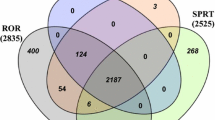Abstract
Objective The proportional reporting ratio (PRR) is a statistical method for signal detection of adverse drug reactions (ADRs) based on unbalanced proportions. Although effective, this method only takes into account the proportional relation based on target adverse reactions and ignores the relation between a given ADR and the others for the same drug. Therefore, it is necessary to improve the calculation deviation in PRR. In this study, we developed a novel PRR (NPRR) method and compared it with the original PRR method for the purpose of a combined application of these two methods for ADR signal detection. Methods NPRR is also based on unbalanced proportions, in which the proportion for a given ADR is linked to a specific drug (or all other drugs), and then divided by the corresponding proportion for all other ADRs. Results Applying this method to the ADR data of Jiangsu Province, China in 2008 and 2009, we detected 3,021 signals. Compared with the PRR method, the sensitivity of our method is 0.99, the specificity is 0.97, and the Youden index is 0.96. Conclusion NPRR is an excellent method supplementary to PRR. The combination of these two methods can reduce calculation deviation and detect ADRs more effectively.

Similar content being viewed by others
References
Edwards IR, Aronson JK. Adverse drug reactions: definitions, diagnosis, and management. Lancet. 2000;356(9237):1255–9.
Evans SJW, Waller PC, Davis S. Use of proportional reporting ratios (PRRs) for signal generation from spontaneous adverse drug reaction reports. Pharmacoepidemiol Drug Saf. 2001;10:483–6.
Rothman KJ, Lanes S, Sacks ST. The reporting odds ratio and its advantages over the proportional reporting ratio. Pharmacoepidemiol Drug Saf. 2004;13:519–23.
Bate A, Lindquist M, Edwards IR, Olsson S, Orre R, Lansner A, De Freitas RM. A Bayesian neural network method for adverse drug reaction signal generation. Eur J Clin Pharmacol. 1998;54:315–21.
Finney DJ. Systemic signaling of adverse reactions to drugs. Methods Inf Med. 1974;13:1–10.
Napke E. The Canadian drug adverse reaction reporting program. Drug Inf J. 1975;9:224–32.
Stricker BH, Tijssen JG. Serum sickness-like reactions to cefaclor. J Clin Epidemiol. 1992;45:1177–84.
Van Puijenbroek EP, Diemont WL, Grootheest K. Application of quantitative signal detection in the Dutch Spontaneous Reporting System for adverse drug reactions. Drug Saf. 2003;26(5):293–301.
Bate A. Bayesian confidence propagation neural network. Drug Saf. 2007;30(7):623–5.
DuMouchel W. Bayesian data mining in large frequency tables, with an application to the FDA spontaneous reporting system. Am Stat. 1999;53:177–89.
Kubota K, Koide D, Hirai T. Comparison of data mining methodologies using Japanese spontaneous reports. Pharmacoepidemiol Drug Saf. 2004;13(6):387–94.
Lugardon S, Desboeuf K, Fernet P, Montastruc JL, Lapeyre-Mestre M. Using a capture–recapture method to assess the frequency of adverse drug reactions in a French university hospital. Br J Clin Pharmacol. 2006;62:225–31.
Acknowledgments
We would like to thank Mr. Zichun Fang for editing this manuscript.
Funding
This study was supported by the National Social Science Foundation of China (09CTQ022) and the 6th Project of Six Industries of JiangSu Province of China (09-E-016).
Conflicts of interest
None to be declared.
Author information
Authors and Affiliations
Corresponding author
Rights and permissions
About this article
Cite this article
Wei, JX., Li, M., Sun, YH. et al. A novel method for signal detection of adverse drug reactions based on proportional reporting ratios. Pharm World Sci 32, 658–662 (2010). https://doi.org/10.1007/s11096-010-9421-x
Received:
Accepted:
Published:
Issue Date:
DOI: https://doi.org/10.1007/s11096-010-9421-x




